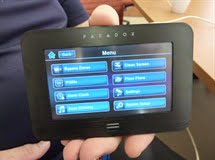NEW from CSD is the TM40 Paradox Touch Screen keypad, an interface that’s compatible with Paradox panels including EVO (Software version V2.16 or higher), Magellan MG5000/MG5050, and Spectra SP5500/SP6000/SP7000 (Version 4.72 or higher) and Spectra SP4000/SP65 (version 4.90 or higher).
In short, the relevant specifications of this touch screen keypad include 10.9cm diagonal widescreen, icon-based interface, menu prompts and customisable labels for keys elements like zones, areas, users and PGM outputs.
Important too, the TM40 controls up to 8 PGM outputs, has an external microSD card slot for firmware upgrades and the uploading of installer logos and end user photos for slideshow display. There’s also a built-in temperature sensor and a single zone input to connect either an intrusion sensor or an exterior temperature sensor.
Something that’s interesting about the TM40 is its ability to play a slideshow of the end users photos – interspersed with logos of the installer if programmed for this. It’s a bit of function that gives the keypad the ability to please even when not being used to drive an alarm system.
I take a look at the TM40 at CSD’s Sydney office and as soon as I get my hands on the keypad it’s clear this is a nice piece of kit. The touch screen we are playing with has a brushed black anodized finish which is very smart. The menu layout is clear, the touch keys are very large – you’re not going to miss these and activate the wrong functions as can often happen with touch technology.
The GUI is simple and easy to use with one-touch arm and disarm, as well as audible tones to indicate successful actioning of touch key strokes. Alarm events are indicated by the touch screen with an audible alert tone. Along with this, the TM40 has a panic with a very loud local tone – panic is very easy to use, too. On an old LED keypad you would be holding down keys 1 and 3 but here it’s a single touch.
“Getting through the programming menu is very easy – it’s a straight forward process,” explains CSD’s Royce. “Paradox has a quick menu function when you are working at keypad level. There are buttons for bypass zones, PGMs, alarm clock, zone chiming, clean screen, floor plans, settings (screen, backlight intensity, auto-dim delay, auto-dim intensity) and system setup.
“All the installer programming can be done from the touch screen – with a lot of panels you have to program using an old-style LCD keypad connected straight onto the board and then install the Touch screen after the programming was done.
“Now you don’t need a separate service keypad. It’s a real all-rounder, this touch screen,” Royce explains. “There’s a wizard allowing you to designate which are wireless or hardwired sensors, you can nominate the location of zones in partitions, select delays. All this makes the touch screen very user friendly.”
CSD’s Mark Edwards says an ancillary benefit of the new Paradox Touch Screen keypad is the ease with which installers take to it.
“The touch screen and wizards that Paradox has put into their programming make things very intuitive. Every time we have a new installer to the industry come through a training session they can walk away in an hour and half and set up a basic system. The touch screen makes programming any Paradox panel easier.
“All the outputs can be programmed through the quick menu – you have a normal bell output but then you’ve got the individual open collector outputs that just switch to negative so you can have a bit of building automation there to operate a gate, air con, a pump, etc, through remote controls or iPhone app. There’s also an extra input on the keypad in case you run out of inputs on the panel.”
Royce agrees programming and mounting of this Touch keypad are very easy.
“There’s a quick connector on the back – you solder up the 4 terminals, test everything is working and away you go,” he explains. “Neat for installers, it’s the size of a normal switching plate and you get a half-height and a full-height mounting block which makes it easier to handle a range of cabling options.
“Programming-wise it’s a lot quicker and easier, too – you can see what you are doing, you’re not trying to guess. It’s a good feeling screen and it feels robust. I initially had a fear of a touch screen for commercial or industrial premises but this keypad is rugged enough to handle this.
“The buttons are far enough apart to operate easily – nothing to get tangled with key next-door as often can happen with fiddly touch screens. You can time it out for 30 seconds while you clean it.”
Making life easy for end users, if there’s an alarm, an indicator on the screen shows alarm-in-memory and you simply click on this and you’re told there was a problem with say, the Family Room PIR. You click on Family Room PIR and a map is generated that shows the exact location of the device on the site.
“The map of the premises lives on the SD card (there’s a port) you can take the map off a home builders plan – Bitmap,” explains Edwards. “There’s a folder on the SD card for up to 8 maps (352 x 272 pixels – 24/32-bit colour), a folder for photos (bitmap 450 x 272 max) you edit the floorplan when you commission the system and add in PIRs by dragging them across.
“You load photos and maps through a PC – and then the Touch screen accesses them from the SD card. You use a micro-SD card reader that slots into a USB and then you drag and drop. You can buy an SD reader for a dollar or 2 online.”
Systems supported by the Paradox Touch Screen include the Magellan, the Spectra and the Digiplex Evo but Royce points out that while there’s support for panel sizes from 4 to 192 zones, the touch screen is not backwards compatible.
“You need the correct firmware which only comes with the latest panels so the Touch Screen is not backwards compatible. But the firmware is on the microSD card, so you can remove a Touch keypad and attach it to another compatible panel and the system will suck in the correct firmware it needs to operate from the card.”
This Paradox Touch Screen keypad is available in 3 finishes: Brushed aluminium, brushed black anodised, and white anodised – that makes meshing the keypad with decor easier to do. What about cost? The Touch keypad is $125 on its own, or $250 as part of a kit including an SP-4000 Spectra panel (4 zones doubles to 8), with PIRs, including GST. That’s very sharp for touch technology.
Another newbie from CSD is iPhone app that allows iPhones to drive Paradox alarm panels, allowing remote control interrogation of the panel to check events like kids getting home from school or to see if the system is armed. You can arm/disarm individual partitions via web browser, and view the live status of all zones and partitions (i.e open/close, arm/disarm, troubles and alarms) via web browser.
Essentially this app turns an iPhone into a local or remote keypad for Paradox alarm panels for just $12.99. Pretty cool, eh? To get the iPhone app working you use the serial-to-ethernet IP100 device. This neat little unit we’ve got pictured here gives the ability to report control panel events via IP to the Paradox IPR512 GPRS/IP Monitoring Receiver, as well as to receive notification of system alarms via email.
On the network site, a DNS service is available for dynamic IP address and there’s support for SMTP and ESMTP (TLS/SSL not supported), low bandwidth consumption. Data is sent and received using 128-bit (MD5 and RC4) or 256-bit (AES) data encryption and there’s 2-way dynamic authentication. That’s important to know from an installer’s point of view. Customer’s systems will not be compromised by operation over the public network.
Key to the Paradox iPhone app is that it allows control and monitoring of a control panel through an IP network (LAN/WAN/Internet), which in this case is a dedicated Paradox site.
According to Royce, the IP100 can work with static IP or Paradox has its own DNS (Paradox MyHome) for dynamic IP addresses. The iPhone app comes in a number of versions. There’s a free version which is a viewer and a full version which is $12.99. You connect to the panel’s IP address – in this demo it’s local as we’re working on the CSD LAN.
Next, Royce uses a PIN number in the app displayed on the iPhone screen and then we’re connected. The app gives Royce the ability to arm and disarm as well to action PGMs. It’s all very neat and the iPhone control screen is very simple and easy to operate.
“Owners of holiday homes love it,” says Royce. “It works overseas. And it will operate PGMs like front gates, front doors, pool pumps, air conditioners.
“It’s a big seller – the IP100 is flying out the door. It can do things like send you an email when the kids get home from school and alarm events – you get those emails on PC or smart phone via the Paradox MyHome website.
“The installer just creates a profile and then adds all clients and then can administer customers on a free DNS server.”
These new releases from CSD reflect the focus on ease of use and networkability of today’s electronic security systems. Nicest of all we can functional benefits for both installers and end users that lift domestic and commercial alarm systems from the static rut in which they’ve spent the last couple of decades. Nice work, Paradox and CSD.
Click to Bookmark Post
Post Bookmarked
25.5
C
Sydney
27.7
C
Canberra
29
C
Darwin
18.9
C
Hobart
20.1
C
Perth
25.9
C
Brisbane
20.8
C
Auckland
21.9
C
Melbourne










